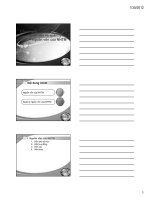BÀI GIẢNG kế TOÁN QUỐC tế chapter 5 ledger accounts and double entry
Bạn đang xem bản rút gọn của tài liệu. Xem và tải ngay bản đầy đủ của tài liệu tại đây (313.47 KB, 18 trang )
Chapter 5
LEDGER ACCOUNTS
AND DOUBLE ENTRY
Learning Objectives
1.
2.
3.
4.
5.
6.
The nominal ledger
The accounting equation
Double entry bookkeeping
The journal and imprest system
Day book analysis
The receivables and payables ledgers
2
The nominal ledger
Ledger accounting:
Is the process by which a business keeps a
record of its transactions:
– In chronological order
– Built up in cumulative totals
A ledger account or ‘T’ account looks like this.
3
The nominal ledger
The nominal ledger:
• Is an accounting record which summarises the
financial affairs of a business.
• Accounts within the nominal ledger include the
following.
–
–
–
–
–
Plant and machinery (non-current asset)
Inventories (current asset)
Sales (income)
Rent (expense)
Total payables (current liability)
4
The accounting equation
CAPITAL
CAPITAL ++ LIABILITIES
LIABILITIES == ASSETS
ASSETS
Capital
Drawings
Investment of funds with
the intention of earning a
return
Amounts withdrawn
from the business by
the owner
The accounting equation is based on the principle that an
entity is separate from the owner.
5
The business equation
P
P == II ++ D
D –– C
Cii
P = profits
I = increase in the entity’s net assets over a period
D = drawings
Ci = increase in capital thanks to an injection of
funds by the owners
6
The business equation
• These two equations are the basis for the
statement of financial position and the income
statement.
• Understanding these will help you understand
the preparation of financial statements.
• Note: In your BPP Learning Media Study Text
you will find the business equation in Chapter
18, as it is an important incomplete records
technique.
7
Double entry bookkeeping
Basic principles
• Double entry bookkeeping is based on the same
idea as the accounting equation.
– Every accounting transaction has two equal
but opposite effects
– Equality of assets and liabilities is preserved
• In a system of double entry bookkeeping every
accounting event must be entered in ledger
accounts both as a debit and as an equal but
opposite credit.
8
Double entry bookkeeping
Debit
Credit
• An increase in an
expense
• An increase in an asset
• A decrease in a liability
• An increase in income
• An increase in a liability
• A decrease in an asset
9
Double entry bookkeeping
• The rules of double entry bookkeeping are best
learnt by considering the cash book.
• A credit entry indicates a payment made by the
business; the matching debit entry is then made in
an account denoting an expense paid, an asset
purchased or a liability settled.
• A debit entry in the cash book indicates cash
received by the business; the matching credit
entry is then made in an account denoting
revenue received, a liability created or an asset
realised.
10
The journal and imprest system
Journal
• Format of journal entries is as follows.
Narrative to explain transaction
Remember: the journal is used to keep a record of
unusual movements between account.
11
The journal and imprest system
Journal entries are often required in an
exam where you would not use the journal
in practice, to save you the time that would
be involved in drawing up ‘T ’account.
12
The journal and imprest system
Imprest system
• The double entry for topping up the petty cash is
as follows:
13
Day book analysis
Day books
• Note that day books are often analysed as in the
following extract (date, customer name and
reference not shown).
14
Day book analysis
• To identify sales by product, total sales
would be entered (‘posted’) as follows.
• Other books of prime entry are analysed in
a similar way.
15
The receivables and payables ledgers
Trade accounts receivable and payable
Trade account receivable
A customer who buys
goods without paying for
them straight away (an
asset).
Trade account payable
A person to whom a
business owes money (a
liability).
Also known as a debtor
Also known as a creditor
16
The receivables and payables ledgers
• To keep track of individual customer and supplier balances
it is common to maintain subsidiary ledgers called the
receivables ledger and the payables ledger. Each account
in these ledgers represents the balance owed by or to an
individual customer or supplier.
• Note that these receivables and payables ledgers are
usually kept purely for reference and are therefore known
as memorandum records. They do not form part of the
double entry system.
• However, some computerised accounting packages treat
the receivables and payables ledgers as part of the double
entry system, in which case separate control accounts are
not kept.
17
The receivables and payables ledgers
Entries to the receivables ledger are made as
follows.
•When making an entry in the sales day book, an
entry is then made on the debit side of the
customer’s account in the receivables ledger
•When cash is received and an entry made in the
cash book, an entry is also made on the credit side
of the customer’s account in the receivables ledger
The payables ledger operates in much the same
way.
18









